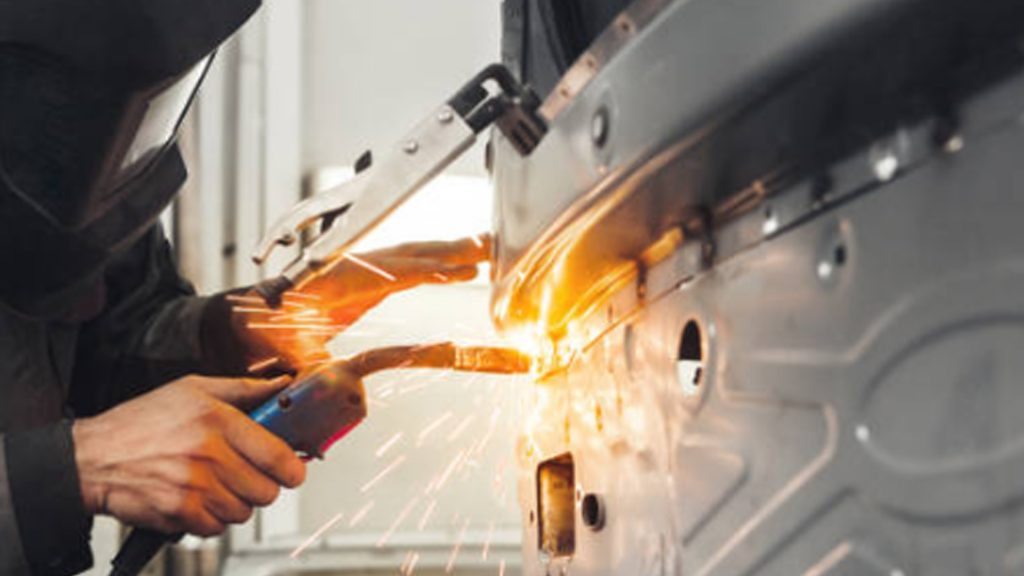
- Use lap joints rather than butt joints
- Make sure the joints are tight and precise, any caps between joints will increase the odds of the burning trough
- Use low settings, thin wire, and fast traveling speed
- Go with tack welding rather than doing longer welds
- Use copper backing bars
- Clean Your base metal properly
If you don’t have many options and you want to give flux core ( FCAW) welding a shot, then there are a few factors and techniques which might help you out. The first thing which you should keep in mind is the settings for the welding job.

For Thinner Than 18-20 Gauge Or 1.0Mm Panel
Most of the official company websites don’t specify the settings for welding this thin metal. I had to do some experimenting and digging to find out what will you need to weld using FCAW.
The wire selection here becomes even more important, so far the Select 700GS was the perfect match for this kind of job. This wire is specifically designed to be worked on thin metals, the diameter to go for would be .030” or 0.8mm.
Running this on 30-40 Amps and 100-120 IPM wire feed speed should do the trick. If you are going to be welding T joints, then aim the welding gun a bit more towards the vertical plate to reduce the chances of blowouts. Try to keep the settings as low as possible although I doubt most FCAW welders will go below 60 Amps.
One thing I would suggest is to do a lot of practice runs before the actual job. You might have to play around with the wire feed speed and the voltage a little bit to find that sweet spot for you.
Other Factors To Keep In Mind
One piece of advice here would be to keep the traveling speed a bit on the higher side. Spending too much time on one spot will easily lead to holes in the metal. A lot of people also blame Flux-Cored welding for producing a lot of spatter and slag. But in reality, some users are welding with the wrong polarity, are using low-quality wire, or don’t clean the base metal properly. Keep in mind that usually FCAW will work with negative or reverse polarity and don’t be cheap!
Welding sheet metals successfully is all about managing the heat. If there is excessive heat on the metal then there will be burn-throughs. There are some very clever techniques through which you can minimize this heat localization.
- The first technique is spot welding, this is a resistance-based welding method wherein two copper electrodes are connected to the sheet metals. Due to the resistance of the base metal, heat is generated when an electric current and pressure are applied through the electrodes. This heat and pressure lead to the two metal pieces being welded. This technique needs different equipment which can be cumbersome and expensive. Another way to do this would be doing a lap joint and drilling a small hole through the top sheet. You can then make a tack weld into the hole, bonding the two sheets together similarly to spot welding.
- Another technique is using a backing bar to dissipate heat faster. You can set up a bar made out of any metal, preferably copper because it conducts heat much more efficiently. Place the copper bar right behind the area you are going to weld. The heat will dissipate much faster when compared to atmospheric cooling. Just to be clear, as body panels are attached to a car, you will have to set the backing bar behind the welding area on the car itself, which in some cases could be impossible
- If you have a choice over the type of joint you can do, I would suggest going for a lap joint over something like a butt joint. The simple reason behind this is that with lap joints, the heat gets to spread over a larger area and there is more metal underneath the heat-affected area. This will further reduce the chances of a burn-through.
Butt joints and lap joints will both need a lot of precision especially if you are using flux-core. For example, doing lap joints, there cannot be any gaps between the two sheets. That’s just asking for trouble. The fastest way to ruin your panel is not to set up the joints tightly. You’ll blow right through the panels



